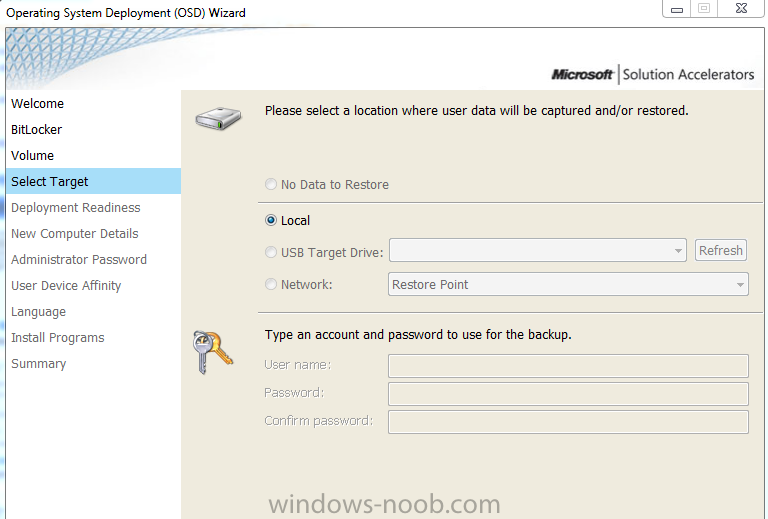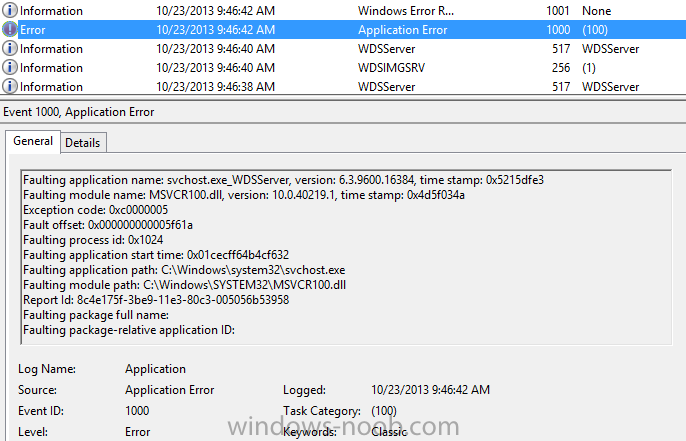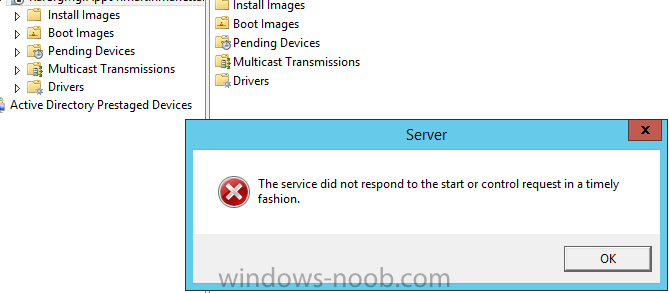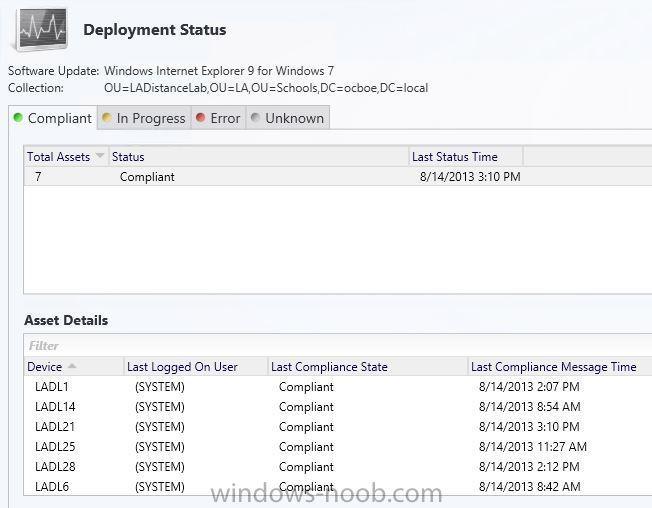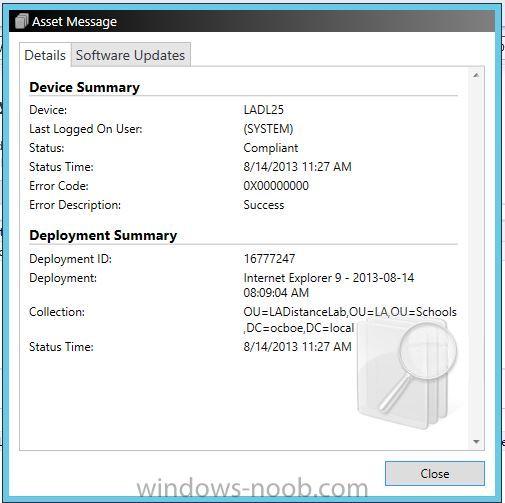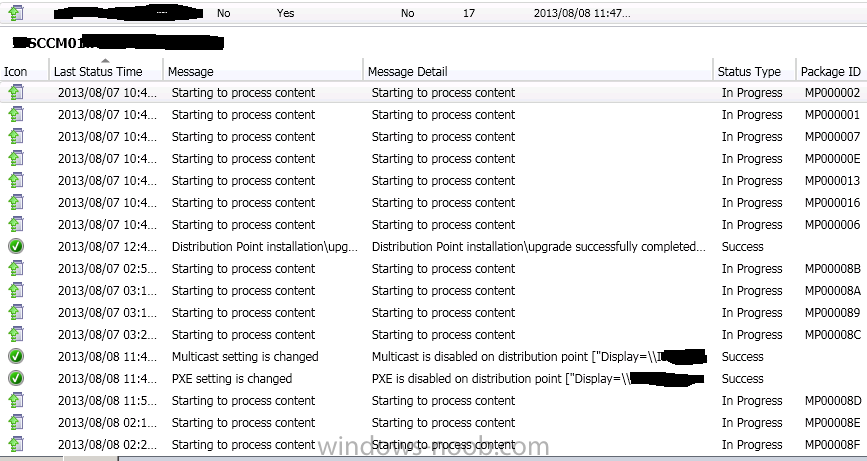Search the Community
Showing results for tags '2012'.
-
Hi, I have a question about reinstalling IIS on SCCM 2012R2. The server has 10 roles (including the Management Point, App Catalog Web Service Point, App Catalog Website Point Services, Reporting Point, Fallback Status Point,). I have a problem such as in this thread: http://scexblog.blogspot.com/2013/12/call-to-httpsendrequestsync-failed-for.html I decided to reinstall IIS. Do you first have to remove all dependent on the IIS roles?
-
I am convinced this is a simple oversight - and I am hoping I am proven right. However, regardless of how I configure the "restore data" page - everything remains greyed out and I cannot make any selections. I have a Backup deployment that backs up the user state .mig data to a share just fine - works wonderfully. Now I am trying to get the UDI wizard, during the deployment of a new computer, to allow me to locate that .mig data and apply it. this is the best picture I could find to represent what I am dealing with, however it's terribly small It's just stuck on "Local" nvm - uploaded a bigger one And even if I get it to work somehow - there is no ability to type in the location of the files? How do I dynamically configure this wizard to select the correct .mig file? This is the final step in building my deployment - I am excited to get it accomplished. We're going live with it next week. Thanks in advance for any and all assistance!
-
Hi all, In all our company uses 8 distribution point and the majority are 2008 R2 domain controllers. About two days ago I have done an inplace upgrade on one server to 2012 R2. The upgrade went mostly without a hitch except for the SCCM DP. The error that I was getting was "access denied" or something along those lines when the site server was attempting to distribute content. So I have tried a lot of things so far to the point where I decided to remove the distribution point and start over. No Joy... I am getting an error on the distribution point in the SCCM console stating "Failed to verify the disk drive". when looking further into the distmgr.log, nothing makes sense to me. please see the below log. ~Sleep 60 seconds... $$<SMS_DISTRIBUTION_MANAGER><05-01-2014 22:20:35.310-600><thread=5576 (0x15C8)> ~Sleep 60 seconds... $$<SMS_DISTRIBUTION_MANAGER><05-01-2014 22:20:44.178-600><thread=5576 (0x15C8)> Upgrading DP with ID 18. Thread 0x1e1c. Used 1 threads out of 5. $$<SMS_DISTRIBUTION_MANAGER><05-01-2014 22:20:59.248-600><thread=5868 (0x16EC)> ~Processing 18.INS $$<SMS_DISTRIBUTION_MANAGER><05-01-2014 22:20:59.253-600><thread=7708 (0x1E1C)> ~DPID 18 - NAL Path ["Display=\\[sERVER NAME HERE]\"]MSWNET:["SMS_SITE=RDO"]\\[sERVER NAME HERE]\ , ServerName = [sERVER NAME HERE], DPDrive = E:, IsMulticast = 0, PXE = 0, RemoveWDS = 0 $$<SMS_DISTRIBUTION_MANAGER><05-01-2014 22:20:59.263-600><thread=7708 (0x1E1C)> Sleep 20 minutes... $$<SMS_DISTRIBUTION_MANAGER><05-01-2014 22:20:59.255-600><thread=5868 (0x16EC)> ~Created policy provider trigger for ID 18 $$<SMS_DISTRIBUTION_MANAGER><05-01-2014 22:20:59.308-600><thread=5860 (0x16E4)> DPConnection::Connect: For [sERVER NAME HERE], logged-on as rondo\sccmpush~ $$<SMS_DISTRIBUTION_MANAGER><05-01-2014 22:21:02.712-600><thread=7708 (0x1E1C)> Found notification for package 'RDO00002' $$<SMS_DISTRIBUTION_MANAGER><05-01-2014 22:21:04.263-600><thread=5576 (0x15C8)> Found notification for package 'RDO00003' $$<SMS_DISTRIBUTION_MANAGER><05-01-2014 22:21:04.268-600><thread=5576 (0x15C8)> Sleep 20 minutes... $$<SMS_DISTRIBUTION_MANAGER><05-01-2014 22:21:04.302-600><thread=5868 (0x16EC)> ~Package Thread Limit: 3 $$<SMS_DISTRIBUTION_MANAGER><05-01-2014 22:21:04.310-600><thread=5576 (0x15C8)> ~Per package Thread Limit: 5 $$<SMS_DISTRIBUTION_MANAGER><05-01-2014 22:21:04.315-600><thread=5576 (0x15C8)> ~Retry interval: 30 $$<SMS_DISTRIBUTION_MANAGER><05-01-2014 22:21:04.320-600><thread=5576 (0x15C8)> ~DP upgrade thread Limit: 5 $$<SMS_DISTRIBUTION_MANAGER><05-01-2014 22:21:04.325-600><thread=5576 (0x15C8)> ~DP upgrade retry interval: 20 $$<SMS_DISTRIBUTION_MANAGER><05-01-2014 22:21:04.330-600><thread=5576 (0x15C8)> ~Used 0 out of 3 allowed processing threads. $$<SMS_DISTRIBUTION_MANAGER><05-01-2014 22:21:04.360-600><thread=5576 (0x15C8)> Failed to find a valid drive on the distribution point ["Display=\\[sERVER NAME HERE]\"]MSWNET:["SMS_SITE=RDO"]\\[sERVER NAME HERE]\ $$<SMS_DISTRIBUTION_MANAGER><05-01-2014 22:21:04.541-600><thread=7708 (0x1E1C)> ~Starting package processing thread, thread ID = 0x88 (136) $$<SMS_DISTRIBUTION_MANAGER><05-01-2014 22:21:04.919-600><thread=5576 (0x15C8)> DPConnection::Disconnect: For [sERVER NAME HERE], reverted to SYSTEM context~ $$<SMS_DISTRIBUTION_MANAGER><05-01-2014 22:21:05.131-600><thread=7708 (0x1E1C)> user(NT AUTHORITY\SYSTEM) runing application(SMS_DISTRIBUTION_MANAGER) from machine ([sITE SERVER NAME HERE]) is submitting SDK changes from site(RDO) $$<SMS_DISTRIBUTION_MANAGER><05-01-2014 22:21:05.348-600><thread=7708 (0x1E1C)> ~Starting package processing thread, thread ID = 0x2B78 (11128) $$<SMS_DISTRIBUTION_MANAGER><05-01-2014 22:21:05.426-600><thread=5576 (0x15C8)> ~Sleep 3600 seconds... $$<SMS_DISTRIBUTION_MANAGER><05-01-2014 22:21:05.434-600><thread=5576 (0x15C8)> STATMSG: ID=2304 SEV=I LEV=M SOURCE="SMS Server" COMP="SMS_DISTRIBUTION_MANAGER" SYS=[sITE SERVER NAME HERE] SITE=RDO PID=3112 TID=11128 GMTDATE=Thu May 01 12:21:05.440 2014 ISTR0="RDO00003" ISTR1="" ISTR2="" ISTR3="" ISTR4="" ISTR5="" ISTR6="" ISTR7="" ISTR8="" ISTR9="" NUMATTRS=1 AID0=400 AVAL0="RDO00003" $$<SMS_DISTRIBUTION_MANAGER><05-01-2014 22:21:05.440-600><thread=11128 (0x2B78)> ~Retrying package RDO00003 $$<SMS_DISTRIBUTION_MANAGER><05-01-2014 22:21:05.450-600><thread=11128 (0x2B78)> No action specified for the package RDO00003. $$<SMS_DISTRIBUTION_MANAGER><05-01-2014 22:21:05.455-600><thread=11128 (0x2B78)> STATMSG: ID=2304 SEV=I LEV=M SOURCE="SMS Server" COMP="SMS_DISTRIBUTION_MANAGER" SYS=[sITE SERVER NAME HERE] SITE=RDO PID=3112 TID=136 GMTDATE=Thu May 01 12:21:05.440 2014 ISTR0="RDO00002" ISTR1="" ISTR2="" ISTR3="" ISTR4="" ISTR5="" ISTR6="" ISTR7="" ISTR8="" ISTR9="" NUMATTRS=1 AID0=400 AVAL0="RDO00002" $$<SMS_DISTRIBUTION_MANAGER><05-01-2014 22:21:05.440-600><thread=136 (0x88)> ~Retrying package RDO00002 $$<SMS_DISTRIBUTION_MANAGER><05-01-2014 22:21:05.469-600><thread=136 (0x88)> No action specified for the package RDO00002. $$<SMS_DISTRIBUTION_MANAGER><05-01-2014 22:21:05.476-600><thread=136 (0x88)> Start adding package to server ["Display=\\[sERVER NAME HERE]\"]MSWNET:["SMS_SITE=RDO"]\\[sERVER NAME HERE]\... $$<SMS_DISTRIBUTION_MANAGER><05-01-2014 22:21:05.494-600><thread=136 (0x88)> Will wait for 1 threads to end. $$<SMS_DISTRIBUTION_MANAGER><05-01-2014 22:21:05.501-600><thread=136 (0x88)> Thread Handle = 00000000000035C0 $$<SMS_DISTRIBUTION_MANAGER><05-01-2014 22:21:05.507-600><thread=136 (0x88)> Start adding package to server ["Display=\\[sERVER NAME HERE]\"]MSWNET:["SMS_SITE=RDO"]\\[sERVER NAME HERE]\... $$<SMS_DISTRIBUTION_MANAGER><05-01-2014 22:21:05.473-600><thread=11128 (0x2B78)> Attempting to add or update a package on a distribution point. $$<SMS_DISTRIBUTION_MANAGER><05-01-2014 22:21:05.501-600><thread=9852 (0x267C)> The distribution point ["Display=\\[sERVER NAME HERE]\"]MSWNET:["SMS_SITE=RDO"]\\[sERVER NAME HERE]\ is not installed or upgraded yet. $$<SMS_DISTRIBUTION_MANAGER><05-01-2014 22:21:05.538-600><thread=9852 (0x267C)> Error occurred. Performing error cleanup prior to returning. $$<SMS_DISTRIBUTION_MANAGER><05-01-2014 22:21:05.546-600><thread=9852 (0x267C)> ~Failed to install DP files on the remote DP. Error code = 15 $$<SMS_DISTRIBUTION_MANAGER><05-01-2014 22:21:05.455-600><thread=7708 (0x1E1C)> ~Drive E: is not valid. Error = 15 $$<SMS_DISTRIBUTION_MANAGER><05-01-2014 22:21:05.566-600><thread=7708 (0x1E1C)> STATMSG: ID=2360 SEV=E LEV=M SOURCE="SMS Server" COMP="SMS_DISTRIBUTION_MANAGER" SYS=[sITE SERVER NAME HERE] SITE=RDO PID=3112 TID=7708 GMTDATE=Thu May 01 12:21:05.573 2014 ISTR0="["Display=\\[sERVER NAME HERE]\"]MSWNET:["SMS_SITE=RDO"]\\[sERVER NAME HERE]\" ISTR1="[sERVER NAME HERE]" ISTR2="" ISTR3="" ISTR4="" ISTR5="" ISTR6="" ISTR7="" ISTR8="" ISTR9="" NUMATTRS=1 AID0=404 AVAL0="["Display=\\[sERVER NAME HERE]\"]MSWNET:["SMS_SITE=RDO"]\\[sERVER NAME HERE]\" $$<SMS_DISTRIBUTION_MANAGER><05-01-2014 22:21:05.573-600><thread=7708 (0x1E1C)> ~Will try again after 20 mins ... $$<SMS_DISTRIBUTION_MANAGER><05-01-2014 22:21:05.582-600><thread=7708 (0x1E1C)> Will wait for 1 threads to end. $$<SMS_DISTRIBUTION_MANAGER><05-01-2014 22:21:05.522-600><thread=11128 (0x2B78)> Thread Handle = 00000000000029C8 $$<SMS_DISTRIBUTION_MANAGER><05-01-2014 22:21:05.612-600><thread=11128 (0x2B78)> Attempting to add or update a package on a distribution point. $$<SMS_DISTRIBUTION_MANAGER><05-01-2014 22:21:05.522-600><thread=10028 (0x272C)> DP thread with array index 0 ended. $$<SMS_DISTRIBUTION_MANAGER><05-01-2014 22:21:06.124-600><thread=136 (0x88)> DP thread with thread handle 00000000000035C0 and thread ID 9852 ended. $$<SMS_DISTRIBUTION_MANAGER><05-01-2014 22:21:06.131-600><thread=136 (0x88)> The distribution point ["Display=\\[sERVER NAME HERE]\"]MSWNET:["SMS_SITE=RDO"]\\[sERVER NAME HERE]\ is not installed or upgraded yet. $$<SMS_DISTRIBUTION_MANAGER><05-01-2014 22:21:06.136-600><thread=10028 (0x272C)> Error occurred. Performing error cleanup prior to returning. $$<SMS_DISTRIBUTION_MANAGER><05-01-2014 22:21:06.164-600><thread=10028 (0x272C)> DP thread with array index 0 ended. $$<SMS_DISTRIBUTION_MANAGER><05-01-2014 22:21:06.198-600><thread=11128 (0x2B78)> DP thread with thread handle 00000000000029C8 and thread ID 10028 ended. $$<SMS_DISTRIBUTION_MANAGER><05-01-2014 22:21:06.205-600><thread=11128 (0x2B78)> ~Package RDO00002 does not have a preferred sender. $$<SMS_DISTRIBUTION_MANAGER><05-01-2014 22:21:06.645-600><thread=136 (0x88)> The package and/or program properties for package RDO00002 have not changed, need to determine which site(s) need updated package info. $$<SMS_DISTRIBUTION_MANAGER><05-01-2014 22:21:06.653-600><thread=136 (0x88)> ~CDistributionSrcSQL::UpdateAvailableVersion PackageID=RDO00002, Version=3, Status=2301 $$<SMS_DISTRIBUTION_MANAGER><05-01-2014 22:21:06.659-600><thread=136 (0x88)> ~StoredPkgVersion (3) of package RDO00002. StoredPkgVersion in database is 3. $$<SMS_DISTRIBUTION_MANAGER><05-01-2014 22:21:06.687-600><thread=136 (0x88)> ~SourceVersion (3) of package RDO00002. SourceVersion in database is 3. $$<SMS_DISTRIBUTION_MANAGER><05-01-2014 22:21:06.694-600><thread=136 (0x88)> STATMSG: ID=2302 SEV=E LEV=M SOURCE="SMS Server" COMP="SMS_DISTRIBUTION_MANAGER" SYS=[sITE SERVER NAME HERE] SITE=RDO PID=3112 TID=136 GMTDATE=Thu May 01 12:21:06.700 2014 ISTR0="Configuration Manager Client Package" ISTR1="RDO00002" ISTR2="" ISTR3="" ISTR4="" ISTR5="" ISTR6="" ISTR7="" ISTR8="" ISTR9="" NUMATTRS=1 AID0=400 AVAL0="RDO00002" $$<SMS_DISTRIBUTION_MANAGER><05-01-2014 22:21:06.700-600><thread=136 (0x88)> ~Failed to process package RDO00002 after 33 retries, will retry 67 more times $$<SMS_DISTRIBUTION_MANAGER><05-01-2014 22:21:06.711-600><thread=136 (0x88)> ~Exiting package processing thread. $$<SMS_DISTRIBUTION_MANAGER><05-01-2014 22:21:06.720-600><thread=136 (0x88)> ~Package RDO00003 does not have a preferred sender. $$<SMS_DISTRIBUTION_MANAGER><05-01-2014 22:21:06.721-600><thread=11128 (0x2B78)> The package and/or program properties for package RDO00003 have not changed, need to determine which site(s) need updated package info. $$<SMS_DISTRIBUTION_MANAGER><05-01-2014 22:21:06.749-600><thread=11128 (0x2B78)> ~CDistributionSrcSQL::UpdateAvailableVersion PackageID=RDO00003, Version=1, Status=2301 $$<SMS_DISTRIBUTION_MANAGER><05-01-2014 22:21:06.757-600><thread=11128 (0x2B78)> ~StoredPkgVersion (1) of package RDO00003. StoredPkgVersion in database is 1. $$<SMS_DISTRIBUTION_MANAGER><05-01-2014 22:21:06.784-600><thread=11128 (0x2B78)> ~SourceVersion (1) of package RDO00003. SourceVersion in database is 1. $$<SMS_DISTRIBUTION_MANAGER><05-01-2014 22:21:06.790-600><thread=11128 (0x2B78)> STATMSG: ID=2302 SEV=E LEV=M SOURCE="SMS Server" COMP="SMS_DISTRIBUTION_MANAGER" SYS=[sITE SERVER NAME HERE] SITE=RDO PID=3112 TID=11128 GMTDATE=Thu May 01 12:21:06.797 2014 ISTR0="Configuration Manager Client Upgrade Package" ISTR1="RDO00003" ISTR2="" ISTR3="" ISTR4="" ISTR5="" ISTR6="" ISTR7="" ISTR8="" ISTR9="" NUMATTRS=1 AID0=400 AVAL0="RDO00003" $$<SMS_DISTRIBUTION_MANAGER><05-01-2014 22:21:06.797-600><thread=11128 (0x2B78)> ~Failed to process package RDO00003 after 33 retries, will retry 67 more times $$<SMS_DISTRIBUTION_MANAGER><05-01-2014 22:21:06.806-600><thread=11128 (0x2B78)> ~Exiting package processing thread. $$<SMS_DISTRIBUTION_MANAGER><05-01-2014 22:21:06.814-600><thread=11128 (0x2B78)> Sleep 20 minutes... $$<SMS_DISTRIBUTION_MANAGER><05-01-2014 22:21:09.311-600><thread=5868 (0x16EC)> ~Package Thread Limit: 3 $$<SMS_DISTRIBUTION_MANAGER><05-01-2014 22:21:10.463-600><thread=5576 (0x15C8)> ~Per package Thread Limit: 5 $$<SMS_DISTRIBUTION_MANAGER><05-01-2014 22:21:10.469-600><thread=5576 (0x15C8)> ~Retry interval: 30 $$<SMS_DISTRIBUTION_MANAGER><05-01-2014 22:21:10.476-600><thread=5576 (0x15C8)> ~DP upgrade thread Limit: 5 $$<SMS_DISTRIBUTION_MANAGER><05-01-2014 22:21:10.482-600><thread=5576 (0x15C8)> ~DP upgrade retry interval: 20 $$<SMS_DISTRIBUTION_MANAGER><05-01-2014 22:21:10.488-600><thread=5576 (0x15C8)> ~Used 0 out of 3 allowed processing threads. $$<SMS_DISTRIBUTION_MANAGER><05-01-2014 22:21:10.509-600><thread=5576 (0x15C8)> ~Sleep 1826 seconds... $$<SMS_DISTRIBUTION_MANAGER><05-01-2014 22:21:10.517-600><thread=5576 (0x15C8)> Sleep 20 minutes... $$<SMS_DISTRIBUTION_MANAGER><05-01-2014 22:21:14.320-600><thread=5868 (0x16EC)> ~Used 0 out of 3 allowed processing threads. $$<SMS_DISTRIBUTION_MANAGER><05-01-2014 22:21:15.544-600><thread=5576 (0x15C8)> ~Sleep 1821 seconds... $$<SMS_DISTRIBUTION_MANAGER><05-01-2014 22:21:15.553-600><thread=5576 (0x15C8)> Sleep 20 minutes... $$<SMS_DISTRIBUTION_MANAGER><05-01-2014 22:21:19.332-600><thread=5868 (0x16EC)> ~Used 0 out of 3 allowed processing threads. $$<SMS_DISTRIBUTION_MANAGER><05-01-2014 22:21:20.581-600><thread=5576 (0x15C8)> ~Sleep 1816 seconds... $$<SMS_DISTRIBUTION_MANAGER><05-01-2014 22:21:20.589-600><thread=5576 (0x15C8)> ~Sleep 1816 seconds... $$<SMS_DISTRIBUTION_MANAGER><05-01-2014 22:21:20.732-600><thread=5576 (0x15C8)> ~Sleep 1816 seconds... $$<SMS_DISTRIBUTION_MANAGER><05-01-2014 22:21:20.872-600><thread=5576 (0x15C8)> So I have two questions, How can I fix this and how do I prevent it from happening to the remainder? Thank you all in advance. Daniel.
-
We need to be able to discover users who have been disabled and update changes made to disabled users. It seems that if a user is disabled in AD, SCCM just ignores them so that it doesn't even update the UAC attribute in the SCCM database. Is there any way to get around this?
-
We are currently running SCCM 2012 R2 on a Windows Server 2012 environment. We deploy Windows 8.1 - 64 bits through a task sequence. Our question is, is it possible to deploy a Wireless profile through a script/package during the OSD task sequence? I've fiddled around with a script using NETSH, and manually i'm able to import / export a profile. However, this only works in the current user context. Unfortunately you cannot use 'user context' driven packages in a task sequence. Is there another method? Thanks in advance.
-
Hi, I have a really odd problem that I’ve never seen before when deploying an OSD TS to an HP ProBook 6560b. I’m deploying Windows 7 Enterprise 64bit using Confg Manager 2012 SP1. I have the latest driver pack for this model from HP (sp61783.exe), and the correct driver pack is selected in the TS using a WMI query. The driver package is installed OK, however the wrong NIC driver is installed. The NIC is an Intel 82579V (PCI\VEN_8086&DEV_1503), however the driver for the 82579LM (PCI\VEN_8086&DEV_1502) gets installed. Checking the setupapi.dev.log I can see that in the first boot session (i.e. after SCCM has copied the drivers to the driverstore and the laptop reboots to install the drivers) the hardware is detected as DEV_1502. The 82579LM driver is selected and installed, however the device fails to start. After the next reboot in the TS the setupapi.dev.log shows that it has detected DEV_1503 and the 82579V driver is installed and the device starts. Things I’ve tested so far: A driver package with only the NIC driver in case another driver was causing the issue. Installing no drivers at all – the device is still detected as the 82579LM. Creating a new driver package. Several different versions of the driver including the latest from Intel rather than HP. A different install.wim (the original just has IE9 slipstreamed, but I get the same result from the install.wim from the Win7 ISO). Running the TS using standalone media. A couple of interesting things: It’s not a hardware problem as it build correctly in our SCCM 2007 environment – using the same drivers. The same TS works correctly on a ProBook 6570b and this has the same 82579V NIC. If I install manually using the Windows 7 DVD the device is detected correctly as the 82579V. Any help VERY much appreciated! first_boot_dev_1502.txt second_boot_dev_1503.txt
-
Hi all, I've a strange problem with my osd task sequence. I created a new Windows 7 x64 SP1 image via build and capture ts and imported it via "Add Oprating System Image". In the properties I can see that it consists of two image 1-1 and 2-2. I configured my osd udi task sequence at "Apply operating system image" that it uses the 2-2 image. Nevertheless the task sequence stops at the apply operating system image step with following errors: The task sequence execution engine failed executing the action (Apply Operating System Image) in the group (Install) with the error code 2147943568 Action output: ... installimage.cpp,1721) installer.install(), HRESULT=80070490 (e:\nts_sccm_release\sms\client\osdeployment\applyos\installimage.cpp,1787) Closing image file D:\_SMSTaskSequence\Packages\CH1000F4\Win7_ENT_SP1_64bit_2013_December.wim Entering ReleaseSource() for D:\_SMSTaskSequence\Packages\CH1000F4 reference count 1 for the source D:\_SMSTaskSequence\Packages\CH1000F4 before releasing Released the resolved source D:\_SMSTaskSequence\Packages\CH1000F4 InstallImage( g_InstallPackageID, g_ImageIndex,targetVolume, ImageType_OS, g_ConfigPackageID, g_ConfigFileName, bOEMMedia, g_RunFromNet ), HRESULT=80070490 (e:\nts_sccm_release\sms\client\osdeployment\applyos\applyos.cpp,509) Unable to find a Windows system root at D:\. lement not found. (Error: 80070490; Source: Windows) Failed to find the system root for the applied OS. lement not found. (Error: 80070490; Source: Windows) Installation of image 1 in package CH1000F4 failed to complete.. lement not found. (Error: 80070490; Source: Windows). The operating system reported error 2147943568: Element not found. Any help would be appreciated.
-
Configuration Manager cannot connect to the site (server.domain.com) I have a handful of users in a group called SCCMADMINS. All users can access the console from their desk and connect to ConfigMgr except for one. The user also tried logging in at another users desk and also could not access the console. That other user logged on before and after to the console successfully. Their is no log at "Program Files\Microsoft Configuration Manager\AdminConsole\AdminUILog". The client was installed from the R2 ISO. Just for a test I added the user explicitely to local admins on the server and in the the console and that person could still not log in. None of the other users are having issues. Any ideas? Thanks
-
Hi, this is my 1st post, and I'm a complete noob to SCCM and Bitlocker. I'm currently using Server 2008 R2, with SCCM 2012 SP1. I've followed various guides online for deploying BitLocker, and have managed to do so successfully....but, In many guides, when created the GPO on the DC for BitLocker, I don't have the option for selecting 'used space only' or 'full disk encryption' Is this option only available with Win8 or Server 2012? I have also read up on using MBAM with SCCM, but I cannot find where you download this from. Any help would be much appreciated. thanks, mdc111
-
I've been waiting for the windows/sccm r2 refresh to look at moving from LANdesk (yeah.... I know) to SCCM 2012. I have set up this same environment about 3 times now in lab environments with 2008r2/2012 and sccm 2012. This build (hoping to make it a production build eventually) is Server 2012 R2 w/SCCM 2012 R2, and I am seeing my WDS service crash immediatly, to the point it will not even start. I wanted to see if anyone else is experiencing this. See attached screenshots for details.
-
Hi Everyone, Firstly I just wanted to say these forums are great. They have helped so much with my installation and management of Configuration Manager at my site. Yesterday I upgraded from Configuration Manager 2012 SP1 (on Server 2008 R2) to Configuration Manager 2012 R2. I followed this guide on this website: http://www.windows-noob.com/forums/index.php?/topic/8451-how-can-i-install-system-center-2012-r2-configuration-manager/ I used the actual release version instead of the Preview Release version in the guide above. The installation went very smoothly just like the guide. At the end I had all green checks and everything seemed fine. Very shortly afterwards we tried to image some machines and noticed they were failing. Diving into our logs using the CMTrace tool we discovered lots of red errors. Within the sitecomp.log it looks like the upgrade on the SMSMP failed or is failing: Remove STORM.MERCEDES.WA.EDU.AU from user group SMS_SiteSystemToSiteServerConnection_MP_MCP SMS_SITE_COMPONENT_MANAGER 23/10/2013 5:42:01 AM 712 (0x02C8) NetLocalGroupDelMembers(MERCEDES\STORM$) failed with (1377) SMS_SITE_COMPONENT_MANAGER 23/10/2013 5:42:01 AM 712 (0x02C8) Starting bootstrap operations... SMS_SITE_COMPONENT_MANAGER 23/10/2013 5:42:01 AM 712 (0x02C8) Installed service SMS_SERVER_BOOTSTRAP_STORM. SMS_SITE_COMPONENT_MANAGER 23/10/2013 5:42:01 AM 712 (0x02C8) Starting service SMS_SERVER_BOOTSTRAP_STORM with command-line arguments "MCP D:\Program Files\Microsoft Configuration Manager /install D:\Program Files\Microsoft Configuration Manager\bin\x64\rolesetup.exe SMSMP "... SMS_SITE_COMPONENT_MANAGER 23/10/2013 5:42:01 AM 712 (0x02C8) Execution of "D:\Program Files\Microsoft Configuration Manager\bin\x64\rolesetup.exe /install /siteserver:STORM.MERCEDES.WA.EDU.AU" on server STORM.MERCEDES.WA.EDU.AU failed: Child process ""D:\Program Files\Microsoft Configuration Manager\bin\x64\rolesetup.exe" /install /siteserver:STORM SMSMP 0" took too long to execute, and the process (PID = 7652) was orphaned. SMS_SITE_COMPONENT_MANAGER 23/10/2013 6:12:07 AM 712 (0x02C8) INFO: 'STORM.MERCEDES.WA.EDU.AU' is a valid FQDN. SMS_SITE_COMPONENT_MANAGER 23/10/2013 6:12:07 AM 712 (0x02C8) Bootstrap operation failed. SMS_SITE_COMPONENT_MANAGER 23/10/2013 6:12:07 AM 712 (0x02C8) Deinstalled service SMS_SERVER_BOOTSTRAP_STORM. SMS_SITE_COMPONENT_MANAGER 23/10/2013 6:12:07 AM 712 (0x02C8) Bootstrap operations aborted. SMS_SITE_COMPONENT_MANAGER 23/10/2013 6:12:07 AM 712 (0x02C8) Reinstallation failed and will be retried in the next polling cycle. SMS_SITE_COMPONENT_MANAGER 23/10/2013 6:12:07 AM 712 (0x02C8) Then within the MPSetup.log it looks like it is trying to update the CCM Client as part of the SMSMP update, but fails: <10/23/13 10:12:27> ======== Installing Pre Reqs for Role SMSMP ======== <10/23/13 10:12:27> Found 3 Pre Reqs for Role SMSMP <10/23/13 10:12:27> Pre Req MSXML60 found. <10/23/13 10:12:27> No versions of MSXML60 are installed. Would install new MSXML60. <10/23/13 10:12:27> Enabling MSI logging. msxml6_x64.msi will log to D:\Program Files\Microsoft Configuration Manager\logs\msxml6_x64MSI.log <10/23/13 10:12:27> Installing D:\Program Files\Microsoft Configuration Manager\bin\x64\00000409\msxml6_x64.msi <10/23/13 10:12:27> msxml6_x64.msi exited with return code: 0 <10/23/13 10:12:27> msxml6_x64.msi Installation was successful. <10/23/13 10:12:27> Pre Req CcmSetup found. <10/23/13 10:12:27> Installing pre-req using command line "D:\Program Files\Microsoft Configuration Manager\client\ccmsetup.exe" /UpgradeWithServer:mp <10/23/13 10:12:27> Pre-req installer "D:\Program Files\Microsoft Configuration Manager\client\ccmsetup.exe" /UpgradeWithServer:mp finished with exit code 1 <10/23/13 10:12:27> Failed to Install Pre Req CcmSetup. Return Code is 1 <10/23/13 10:12:27> This was a required Pre Req, can not continue. <10/23/13 10:12:27> Installation Failed. Error Code: 1 <10/23/13 10:12:27> ~RoleSetup(). Then in the client.msi.log it shows more errors with the CCM Client: MSI (s) (74:E8) [10:12:30:507]: Product: Configuration Manager Client - Update '{15424A7E-6B05-4134-8598-1DBE006CEC12}' could not be installed. Error code 1642. Additional information is available in the log file C:\Windows\ccmsetup\Logs\client.msi.log. MSI (s) (74:E8) [10:12:30:507]: Windows Installer installed an update. Product Name: Configuration Manager Client. Product Version: 5.00.7958.1000. Product Language: 1033. Manufacturer: Microsoft Corporation. Update Name: {15424A7E-6B05-4134-8598-1DBE006CEC12}. Installation success or error status: 1642. MSI (s) (74:E8) [10:12:30:508]: Note: 1: 1708 MSI (s) (74:E8) [10:12:30:508]: Product: Configuration Manager Client -- Installation failed. MSI (s) (74:E8) [10:12:30:508]: Windows Installer installed the product. Product Name: Configuration Manager Client. Product Version: 5.00.7958.1000. Product Language: 1033. Manufacturer: Microsoft Corporation. Installation success or error status: 1642. MSI (s) (74:E8) [10:12:30:510]: Attempting to delete file C:\Windows\Installer\3df4d0c.msp We have tried removing the Management Point and re-adding it. This has not fixed the issue. The same errors remain. Has anyone had any similar issues or does anyone have any idea on what may be the issue? Any help is much appreciated. Topher Wilkes
- 6 replies
-
- configuration manager 2012 r2
- configuration
-
(and 5 more)
Tagged with:
-
Hi All Im after a software report in SCCM 2012 that will give me everything that the 'Software 02E - Installed Software on a specific computer' gives me but i want to exclude certain Product Family/Categorys? Anyone know if this is possible? other than exporting to Excel and manipulating Many Thanks in Advance Regards Mark
- 1 reply
-
- sccm 2012
- sccm reports
- (and 8 more)
-
applications fail to install during task sequence
curns posted a topic in Configuration Manager 2012
Hi All, I have SCCM 2012 SP1 with CU3 installed and I'm having trouble installing applications during a build and capture task sequence. I have a single site, with the MP in a data center and a local DP / PXE server in the office. I only installed CU3 on the primary site server as I was under the impression it doesn't need to be installed on DP's (please correct me if I am wrong!) Below are some snippets from the smsts.log file. ... NotifyProgress received: 16 (Application failed to evaluate ) InstallApplication 15/10/2013 11:08:01 AM 596 (0x0254) ... Policy Evaluation failed, hr=0x87d00267 InstallApplication 15/10/2013 11:08:01 AM 2068 (0x0814) ... Install application action failed: '7-Zip'. Error Code 0x87d00267 InstallApplication 15/10/2013 11:08:01 AM 2068 (0x0814) ... Install Static Applications failed, hr=0x87d00267 InstallApplication 15/10/2013 11:08:01 AM 2068 (0x0814) ... Failed to run the action: Install Applications. Download failed (Error: 87D00267; Source: CCM) TSManager 15/10/2013 11:08:01 AM 1524 (0x05F4) ... The execution of the group (Build the Reference Machine) has failed and the execution has been aborted. An action failed. Operation aborted (Error: 80004004; Source: Windows) TSManager 15/10/2013 11:08:01 AM 1524 (0x05F4) Failed to run the last action: Install Applications. Execution of task sequence failed. Download failed (Error: 87D00267; Source: CCM) TSManager 15/10/2013 11:08:01 AM 1524 (0x05F4) ... I get the same error regardless of what application i choose. I have ticked the option "allow this application to be installed from the Install Application task sequence action without being deployed" Any help is appreciated!- 6 replies
-
- applications
- SP1
-
(and 3 more)
Tagged with:
-
Here i'm again. I'm getting frustrated Situation, i'm about to install MDT 2012 to upgrade our MDT 2010. No the 'problem' is that some off the customsettings features like computername are changed in osdcomputername, some things are deprecated some are new features. So far so good. I have installed the deploymentshare on to DFS and now i like to customize my settings into SQL, based on locations and gateway. Here is my customsettings.ini [settings] Priority=Locations, Default Properties=MyCustomProperty [Default] EventService=http://server:9800 [Locations] SQLServer=server.domain DBID=user DBPwd=***** Instance=MSSQLSERVER Port=1433 Database=DEV_MDT Netlib=DBNMPNTW Table=Locations Parameters=DefaultGateway When i check by following url the connection to my DB everything is going well http://deployment.xtremeconsulting.com/tag/ztigather/ This is my ztigather.log, i have filtered out where the sql section Added new custom property MYCUSTOMPROPERTY Using from [settings]: Rule Priority = LOCATIONS, DEFAULT ------ Processing the [LOCATIONS] section ------ Determining the INI file to use. Using DEFAULT VALUE: Ini file = \\server\CustomSettings.ini Finished determining the INI file to use. Using specified INI file = \\%server%\CustomSettings.ini CHECKING the [LOCATIONS] section Using from [LOCATIONS]: SQLServer = server.domain Using from [LOCATIONS]: Instance = MSSQLSERVER Using from [LOCATIONS]: Port = 1433 Using from [LOCATIONS]: Database = DEV_MDT Using from [LOCATIONS]: Netlib = DBMSSOCN Using from [LOCATIONS]: Table = Locations StoredProcedure key not defined in the section [LOCATIONS] Using from [LOCATIONS]: DBID = user Using from [LOCATIONS]: DBPwd = ******** SQLShare key not defined in the section [LOCATIONS] ParameterCondition key not defined in the section [LOCATIONS] Default ParameterCondition 'AND' will be used for building queries with multiple parameters. OPENING STANDARD SECURITY SQL CONNECTION to server server.domain using login user. <Message containing password has been suppressed> Successfully opened connection to database. About to issue SQL statement: SELECT * FROM Locations WHERE DEFAULTGATEWAY IN ('10.4.176.1','fe80::be16:65ff:fe87:d701') Successfully queried the database. Records returned from SQL = 1 Property LOCATION001 is now = Test Added LOCATION value from SQL: LOCATION = Test ------ Processing the [DEFAULT] section ------ Property SLSHAREDYNAMICLOGGING is now = \\server\SLShareDynamicLogging\%OSDComputername% Using from [DEFAULT]: SLSHAREDYNAMICLOGGING = \\server\SLShareDynamicLogging\%OSDComputername% Property EVENTSERVICE is now = http://server:9800 Using from [DEFAULT]: EVENTSERVICE = http://server:9800 ------ Done processing \\server\CustomSettings.ini ------ Correct me if i'm wrong but the sql connection is OK, the select statement results OK but he's not processing the rule from Test that are set in the DB. Can somebody please help me !
-
Move MDT DS from physical PC to SCCM 2012
imfusio posted a question in Microsoft Deployment Toolkit (MDT)
We began creating our Win 7 image in MDT 2012, but the image was created with MDT on a physical Win7 x64 machine in my cubicle. The image and deployment share look good, LTI task sequence, drivers, base OS and scripts are all set - it's ready to go! But we want to deploy it with SCCM. We have an SCCM 2012 SP1 Hierarchy w/CAS environment setup. I searched around a lot, looked through guides, but haven't found a solution for this scenario yet: Q: What would I need to do to take my existing MDT deployment share from this physical PC, and move it to SCCM? So that there would be no dependency on the original physical PC. I assume I'd need to install MDT on the SCCM CAS and copy the entire DS to it? I'm a bit lost at where to start from this point, and would appreciate any input. Thanks! -
SCCM Software License Management with Slickey License Manager
Tony_Dewhurst posted a question in Asset Management
Firstly, if you intend to rely, solely, on ConfigMgr for software license management & compliance – think again! According to Microsoft this functionality within the suite has its limitations. Microsoft admits to these ‘limitations’ within the ConfigMgr Asset Intelligence Documentation (http://technet.microsoft.com/en-us/library/gg681998.aspx) Asset intelligence is a feature in ConfigMgr that utilizes special hardware inventory classes, a set of reports and a catalog that is periodically updated by Microsoft. The section of the documentation which describes the limitations is below: Legal Limitations The information displayed in Asset Intelligence reports are subject to many limitations and the information displayed in them does not represent legal, accounting, or other professional advice. The information that is provided by Asset Intelligence reports is for information only and should not be used as the only source of information for determining software license usage compliance. The following are example limitations involved in inventorying installed software and license usage in the enterprise by using Asset Intelligence that might affect the accuracy of Asset Intelligence reports: Microsoft license usage quantity limitations The quantity of purchased Microsoft software licenses is based on information that administrators supply and should be closely reviewed to ensure that the correct number of software licenses is provided. The reported quantity of Microsoft software licenses contains information only about Microsoft software licenses acquired through volume licensing programs and does not reflect information for software licenses acquired through retail, OEM, or other software license sales channels. Software licenses acquired in the last 45 days might not be included in the quantity of Microsoft software licenses reported because of software reseller reporting requirements and schedules. Software license transfers from company mergers or acquisitions might not be reflected in Microsoft software license quantities. Nonstandard terms and conditions in a Microsoft Volume Licensing (MVLS) agreement might affect the number of software licenses reported and, therefore, might require additional review by a Microsoft representative. Installed software title quantity limitations Configuration Manager Clients must successfully complete hardware inventory reporting cycles for the Asset Intelligence reports to accurately report the quantity of installed software titles. Additionally, there might be a delay between the installation or uninstallation of a licensed software title after a successful hardware inventory reporting cycle that is not reflected in Asset Intelligence reports run before the client reports its next scheduled hardware inventory. License reconciliation limitations The reconciliation of the quantity of installed software titles to the quantity of purchased software licenses is calculated by using a comparison of the license quantity specified by the administrator and the quantity of installed software titles collected from Configuration Manager client hardware inventories based on the schedule set by the administrator. This comparison does not represent a final Microsoft conclusion of the license positions. The actual license position depends on the specific software title license and usage rights granted by the license terms. However, should you wish to use the Asset Intelligence feature for License Management regardless of its limitations, the following steps will need to be completed. A CSV file containing all license information will need to be created. A sample CSV License file is here:Not all fields need to be completed, however the following fields are mandatory; Name, Publisher, Version and EffectiveQuantity. All dates within this CSV need to be in the US format i.e. mm/dd/yyyy. Name & Version must match what is in the ConfigMgr DB – I (or another ConfigMgr Admin) can sort this. This CSV needs to then be imported into ConfigMgr; Open the console and navigate to Assets And Compliance -> Asset Intelligence. Right click on Asset Intelligence and select Import Software License. Run through the wizard ensuring you select General License statement when given the choice. Software Licenses can then be reported on. Navigate to Monitoring -> Reporting Run the report named License 15A – General License Reconciliation Report This will show you a basic report containing license count, usage and more importantly the difference between them both Is this reliable? No! Could you use this as evidence during a compliance audit? Definitely not. Is it real-time? No, it can be days, weeks or even months out of date. What other options are there? There are a multitude of discovery tools available on the market, including tools from 1E, Snow, LicenseDashboard etc – these all range in price, but from our experience, 15-20GBP per client per annum is the norm. These tools generally ‘plug-in’ to ConfigMgr and make use of Asset Intelligence, Software Metering and their own DBs to give you a bigger picture of your licensing within the enterprise. Toolsets: 1E AppClarity: http://www.1e.com/it-efficiency/software/appclarity-software-asset-management/ Snow License Manager / Inventory: http://snowsoftware.com/website1/1.0.1.0/12/2/ LicenseDashboard: http://www.licensedashboard.com/ If, like many enterprises, you are in the process of moving towards a new Windows 7 platform along with a new implementation of Configuration Manager 2012 – take this as an opportunity to get hold of your licensing and manage it correctly. Knowing where software is installed can now become a business process rather than a technical investigation – and its easy! ConfigMgr 2012 also offers Software Metering – i.e. Is software deployed but not being used? We can determine this easily, and with a bit of simple SQL Querying we can automate the removal of the application. The one issue which still blights most enterprises is how to prevent deployment of applications when no licenses are remaining. In an ideal world, this wouldn’t be an issue, as the whole software approval process would look something like this: User requests a licensed application Service Desk passes the call to relevant parties; Whoever deals with software license purchasing to check license availability, costs etc IT Department to potentially ‘push back’ and ask for business justification and potentially suggest other software (Maybe a viewer is a better option?) Users manager to approve the ‘need’ for the software and potentially, the costs to his/her departmental budget CMDB guys to record software asset deployment Once the Service Desk has the required approval, the call is passed to ConfigMgr Administrator or Infrastructure guys to either (for example): Approve request from ConfigMgr Console Add the user to the relevant AD group for deployment. If, when the call gets to 2a/b/c there are no licenses left, and the users manager approves the cost then more should be purchased prior to the call being forwarded to next person/department. No manual installs should ever take place. Unfortunately, the above process is nearly always flawed. Another issue which impacts most enterprises is the recovery of licenses from lost, stolen or broken machines, or users who have left the company – its usually a dirty process which in most case is left to luck, and crossed fingers. There is a tool available on the market which can prevent deployment of applications if no licenses are available, easily recover licenses from lost, stolen or broken machines and even from users who have left the company. It can even help bring existing software installations under control. Slickey License Manager (http://www.slickey.com) can be easily implemented and work alongside ConfigMgr and/or any discovery tool. If you need would like to see a demo of Slickey contact us today to book a demo. Disclaimer: This is an advertisement with permission from windows-noob.com. -
Hi All, I really hope someone can help me with this sudden problem I'm experiencing. I'm trying to deploy a TS on some Dell Optiplex 320s and the TS is *suddenly* failing. It fails at the point of installing applications, installing the first two and then failing on the rest. I know the wim is fine because I've used the same one for deploying to other machines and it works fine. The logs point to an issue with WMI with entries such as An extract of the log file is below: Should I run a command before the application install task to clear/reset the repository or has anyone got any other ideas? Thanks in advance
-
I apologize if the scope of this question gets too big, but I have a question about setting up a Distribution Point, after I've already setup a standalone primary site. From what I have been reading online, it's not hard to create a hierarchy after the fact, but I do have a few questions on how to properly setup SCCM for storage. I learned the hard way that SCCM downloads the files directly to the server (if it's a distribution point) rather than just running the files from a network share. After reading online, I understand this a little better based on having a wide geographic location within a SCCM hierarchy, but it's now caused a problem with storage space on my server. If my second server will just be a distribution point, do I still need to expand the hierarchy (since it's currently a standalone primary)? Is there a proper way to setup the partitions on the server? For example, C drive only 40 GB and E drive as 1 TB. Will SCCM then use the E drive for storage when you enable the distribution point role? If there are other partitions, do you need to create the NO_SMS_ON_DRIVE.SMS files in the root of each partition? Source: http://www.cireson.com/sccm-tips/sccm-tips-1-how-to-control-sccm-data-storage-locations/ Could you simply add some SAN space to the current server to replace the small data partition that is filled up? Thanks for the help! Brad Meyer
-
I'm using SUP to deploy IE9 to my clients. This should be straightforward. I created a software update package and deployed it to a collection. SCCM 2012 is showing that these clients are compliant, but on the clients IE9 is not there even after a reboot. I've attached two screens showing that the clients are showing they're indeed compliant and the software installed with success. IE 9 is not on any of those machines though. I've watched logs, and not seeing any errors (probably because it's showing updated). On one machine I tried to update Windows from the internet, and noticed that IE9 was available. SCCM 2012 is reading it as compliant, but it's obviously not installed. Am I missing something?
-
Hi All I am stuck with a problem in SCCM 2012. It is unable to distribute newly packaged content. The DP just says "starting to process content" and doesnt change. I have removed the DP from the server and re-added it. Reinstalled IIS Recreated the package(s) Installed update http://support.microsoft.com/kb/2854009 I still have the issue, All the distmgr.log file says it "Package is already in the queue" One thing to note: I tested the DP by removing the SMSPKG (driveletter) $ share, but recreating the DP does not re-create this share. This started mid July, no SCEP definitions are currently being deployed. All work has been done on the Primary Site server, the data for the packages are also stored on this server. Version 5.00.7804.1000 Build number 7804 Thank you Morne
-
Morning, I have the opportunity to upgrade my SCCM 2012 SP1 server base OS to Server 2012. In addition, I now have the capacity to spread the load of the SCCM server across multiple SCCM servers. But before I dive in, I would like to know a few things that do not seem to be well documented. Has anyone tried to Upgrade a Server 2008 R2 to a Server 2012, with said server being an SCCM 2012 server? What were Your results\impressions? Would it be better to setup new servers instead? I aim to spread the various SCCM functions over several machines (until now, 1 server has been doing ALL the SCCM tasks) I know its possible to export the Task Sequences, but is it possible to export the Device and User lists from one SCCM to another? How would this affect the SCCM Clients? Can the backup data be used for this? My goal is to have 1 main server With the main roles, a Distribution/Update server, a Reporting & Catalog server and then the Fallback server. All will be running Server 2012. This is one site with a Device and user Count of 2000. Cheers and thanks in advance! Anthony
- 3 replies
-
- migratesccm
- 2012
- (and 6 more)
-
Our environment has some dedicated virtual machines acting as file servers only. The largest one still runs Server 2003, with three big virtual disk volumes. I'm beginning to deploy Server 2012 and one file-only server is working well, including file deduplication. I would hand-copy files from one server to the other, but sysadmins are a lazy lot and I wondered if I could just detach a volume from the 2003 server, attach it to the 2012 server, and enable 2012 deduplication on it. I would then recreate the shares on the 2012 server and hope that the file system permissions remained in tact; both servers are domain members. I'd also have to edit logon scripts and home folders to point to the new mappings; no big deal there, and I'd have to do that anyway. The underlying environment is vSphere 5.1, but I wouldn't expect the server VMs to behave differently if this were Hyper-V. --
-
Hello All We are having an issue with our new SCCM Environment. SCCM was happily working, Deploying OS's, Installing and Uninstalling applications and the other day just stopped Uninstalling applications. It will install but wont remove. We are SCCM 2012 SP1 installed on Server 2008R2 we have a Standalone site and our Collections are populated via Querying AD Groups. Our Install and Uninstall Collections are updating and when we check the deployments within properties on the Device it shows the relevant 'Install' or 'Removal' for the required application. What we have noticed is: Before we had the problem even if we didnt have an application installed, within the Software Centre the application would be listed with a Status of Not Installed - Now it does not. If we delete the deployment and recreate we get the same issue If we delete the collection and recreate and then create a new deployment we get the same issue If we create a new application and create an uninstall deployment on the old collection it works We have looked through a lot of logs and have found some errors, not sure of which to post as not sure what is relevant. Can anyone offer any advice? Many Thanks Mark Jones
-
I have always have an issue with clients (servers and desktops) getting stuck at downloading updates and never progressing even after days. I have read numerous posts here and on technet about this issue and I am still not able to fix it. I want to think that because its so widespread that its something with boundaries but I'm not sure. I have 6 boundaries for 6 different physical locations and they were all added from ad sites not subnets. I have 3 boundary groups which contain the majority of the boundaries. (some offices have closed but the ad sites still exist for now). Which logs would help me determine if its a boundary or an update / update group issue?
- 1 reply
-
- boundaries
- sccm2012
-
(and 2 more)
Tagged with:
-
Hello everyone; SCCM 2012 server agent deployment process, while I ran into the following error logs. I wonder what could be the reason? "the agent has not collected files matching the file name "*.exe" or the path "*\*" from this computer because the files exceed the maximum size limit of 512 kb. you may need to reconfigure the maximum size limit to allow file collection at the next scheduled agent interval." Thank you.


